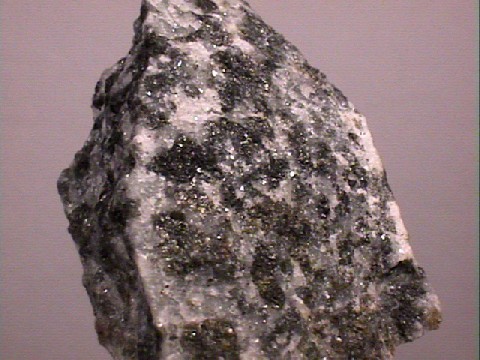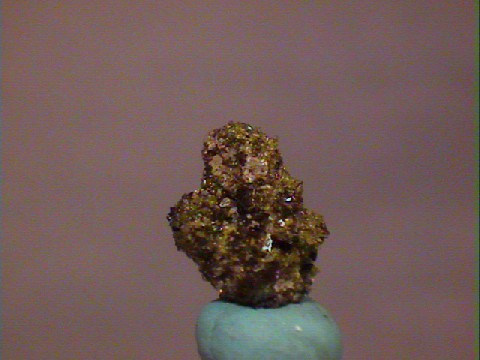 |
THE MINERAL OLIVINE |
 |
- Chemistry: (Mg, Fe)2SiO4, Magnesium Iron Silicate.
- Class: Silicates
- Subclass: Nesosilicates
- Group: Olivine
- Uses: As gemstones, industrial uses as refractory sands and abrasives, an ore of magnesium and as mineral specimens.
Specimens - Also see variety specimens:
Peridot Specimens
Olivine is known by many names. Besides its actual mineral names, forsterite and fayalite, it is known as "chrysolite", "evening emerald" and peridot. The term chrysolite is an old German name that was applied to gemmy olivine, but now is only sometimes used to refer to light yellowish green olivine. Evening emerald is a name given to olivine's gemstone variety, peridot, by some jewelers in some attempt to increase the apparent value of the stones.
Olivine's gemstone variety, known as peridot, is one of the most mispronounced of gemstone names. The correct pronunciation has peridot rhyming with doe or depot. But peridot is often pronounced incorrectly so that it rhymes with dot. Peridot is the birthstone of August and is usually a very affordable colored gemstone. Unfortunately it is often compared to the rich dark green of emerald and in this comparison it is found lacking. But peridot has its own unique green-yellow color that is different from emerald and this comparison is rather unfair. Most peridot is actually the magnesium rich forsterite and its color is caused by the presence of iron ions. Fayalite's higher iron content make for darker, less attractive specimens that are not generally used as gemstones. The best colored peridot has an iron percentage less than 15% and includes nickel and chromium as trace elements that may also contribute to the best peridot color. Peridot is a colorful, affordable and attractive gemstone.
Olivine is found in ultramafic igneous rocks and marbles that formed from metamorphosed impure limestones. Mafic is a word that is used to define igneous rocks with a high iron and magnesium content. The "MA" is for magnesium while the "F" is for ferrum, the latin word for iron. The olivine minerals have a high melting point and are the first minerals to crystallize from a mafic magma. Forsterite crystallizes first with fayalite crystallizing last when other minerals such as the pyroxenes are just beginning to form. The early crystallization of olivine is the reason that molten lavas can contain already crystallized grains of olivine. Some ultramafic rocks can be composed of almost all olivine and these are called dunites or peridotites. Peridotites contain the same chemical makeup as the molten magma in the Earth's mantle. Thus peridotite could be called the most common rock by volume in the Earth, although on the Earth's surface and in the crust it is not nearly as well represented.
Olivine can be altered to the mineral serpentine and this mineral is found in kimberlites, ophiolites and gabbros that started out with large amounts of olivine at one time. Some serpentine (especially from Snarum, Norway) has pseudomorphed crystals of serpentine preserving the outward shape of what was originally an olivine crystal.
Olivine is also found in many iron-nickel meteorites. Not just as small grains but as significantly sized crystals sometimes occupying over 50% of the meteorite's volume. Thinly cut slices of these meteorites are extremely attractive with the polished steel gray of the iron and the embedded grains of gemmy green olivine. The effect produces the closest mineral equivalent to stained glass artwork.
PHYSICAL CHARACTERISTICS:
- Color is a light near emerald green to the more common pale yellowish green; also found colorless, greenish brown to black. A near colorless specimen is likely nearly pure forsterite, while a greenish-brown to black specimen may approach pure fayalite in composition. Anything in-between is olivine.
- Luster is vitreous.
- Transparency: Crystals are transparent to translucent.
- Crystal System is orthorhombic; 2/m 2/m 2/m.
- Crystal Habits include flatten tabular to box shaped crystals, but good crystals are rare. More commonly found as grains in alluvial gravels and as granular xenoliths in magnesium rich volcanic rock. Also massive. Twinning is rare, but has produced star shaped trillings.
- Cleavage is poor in two directions at 90 degrees, is more distinct in fayalite.
- Fracture is conchoidal.
- Hardness is 6.5 - 7.
- Specific Gravity is approximately 3.2 for forsterite - 4.3 for fayalite (above average for non-metallic minerals).
- Streak is white.
- Other Characteristics: Index of refraction is 1.64 - 1.70 and has double refraction.
- Associated Minerals are diopside, spinel, plagioclase feldspars, chromite, hornblende, serpentine, iron-nickel meteorites and augite.
- Notable Occurrences are numerous and include the ancient source of Zagbargad Island in the
Red Sea off the coast of Egypt; Mogok, Myanmar (formerly known as Burma); South Africa;
Ural Mountains , Russia; Kohistan, Pakistan; Norway; Sweden; France; Minas Gerais, Brazil; Eifel, Germany; Chihuahua, Mexico; Ethiopia; Victoria, Australia; China and Salt Lake Crater, Oahu, Hawaii; North Carolina; New Mexico and Peridot Mesa, San Carlos Apache Reservation, Gila County, Arizona, USA. - Best Field Indicators are color, hardness, mafic igneous or metamorphic environment of formation, lack of good cleavage and density.




